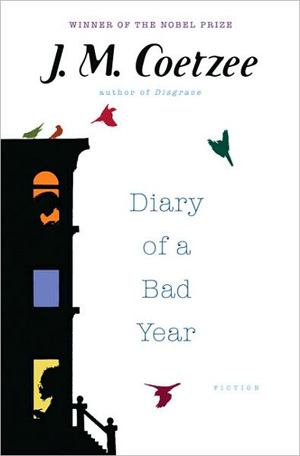Date Finished: October 3
Summary: Senor C is writing a book about his opinions and hires Anya, an attractive young typist to type it for him. Over the course of a months, Anya's boyfriend, Alan, creates a plot to do something horrible to the elderly Senor C. Does Anya have the power to stand up for herself and Senor C?
Likes: This novel was told in three different parts. Typically there were three sections per page, one with Senor C's opinions, the second his narrative, and the third in Anya's point of views. Each of these pieces were somewhat independent of each other, yet fit together as well. There are parts that you can't really skip over (though you can skim), because each part is necessary to the overall format of the novel. I don't think each piece would have been interesting to read as separate pieces. Without the other two narratives, Senor C's opinions seem to be essays that I don't necessarily find interesting. If the story was just Anya or Senor C's narrative, it wouldn't be as interesting if we couldn't read what Senor C's exact opinions are. They could each work separately though, but they compliment each other well.
Dislikes: It took me a while to get used to the format, especially when some sections seem to be read horizontally. Sometimes the narrative need to be finished before moving on the next section and there were gaps of white space where this could have taken place. There is a whole section where Senor C's ruminations go blank and I was wondering why that was.
Overall: What you can learn from this novel, and perhaps the reason the teacher had us read it was that an author isn't always confined by structure. I learned that you can write a story in an format and structure that you want and you can break the rules at times (there is one section that is just all opinion which I found interesting.) What makes the story work in this structure is that all the pieces fit together. If someone were to experiment with this format, they need to make sure that each piece could somewhat standalone and yet compliment each other as well. Our teacher likens this to jazz and since I was/still am somewhat of a musician it makes sense to me. If a saxophone were to play by itself, it would sound beautiful, but when accompanied by other instruments, the sax is complimented and yet you can pick out exactly what melody or harmony its playing. Sometimes it takes a backseat and lets another instrument take the spotlight and sometimes it enhances another instrument. If you took it out, you'd notice that something was missing and when you play it when it's not supposed to be there, it would be too much.
I guess for this format to work, a novelist would want to know what plot threads compliment each other and when do they need to shine and when do they need to be silent. They need to fit together in a way that show that each piece can stand on its own, but is enhanced with the other pieces.
Recommended by: Professor Winer, required reading for Survey of Contemporary Fiction
Acquired: Amazon.com



1 comment:
heyyzz Im given ya the "One Lovely Blog" Award bc u like soo deserve it C=
Go here to figure out what you do now: http://theclumsyreader.blogspot.com/2010/09/one-lovely-blog-award.html
Have your self a Lovely day and hope you get a book on your wish list ^_^
Post a Comment